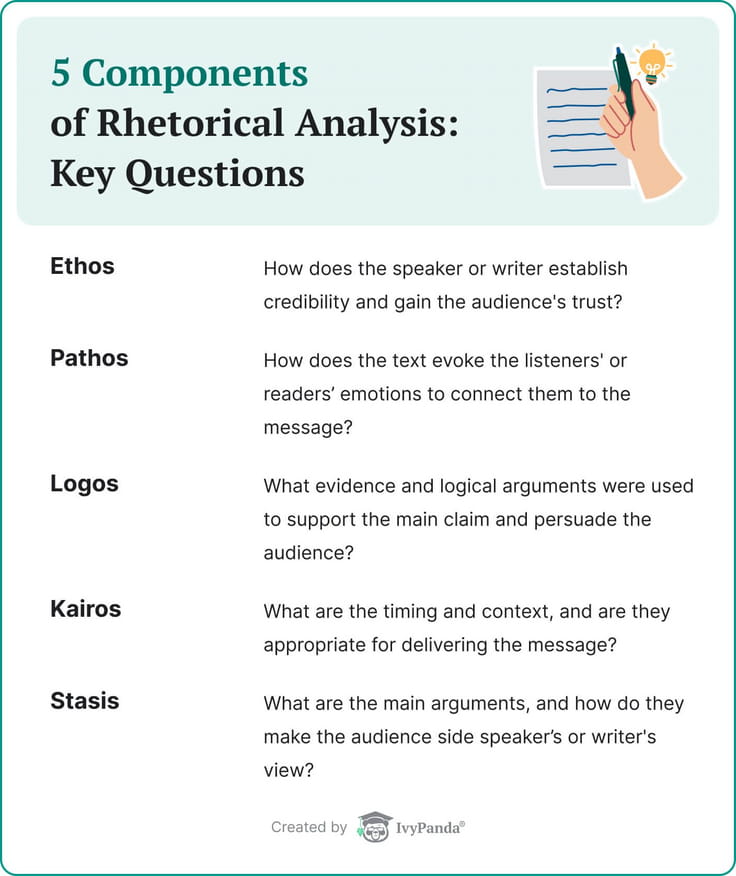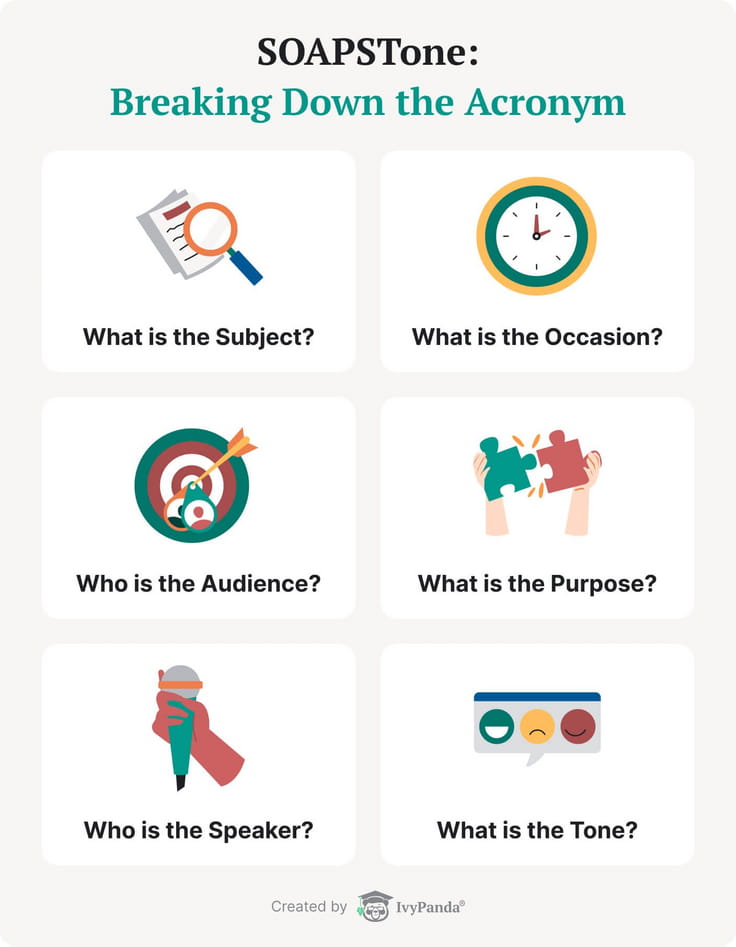Free Rhetorical Analysis Generator
🌟 Intro to Our Free Rhetorical Analysis Generator
Rhetoric refers to the use of language that helps motivate, persuade, or get the point across to a particular audience. Rhetorical analysis involves studying and evaluating strategies authors and speakers use to achieve this goal. Here, you’ll learn how to use our generator, the fundamentals of rhetorical analysis, and the components of making a great essay.

Rhetorical Analysis Generator & Reasons to Try
It’s not always easy to conduct a good rhetorical analysis. Many students struggle with it and may even fail to submit their work on time. Our rhetorical analysis generator is here to help! It has many benefits that help you finish your work faster:
🤔 What Is Rhetorical Analysis?
A rhetorical analysis evaluates a piece of work and the effectiveness with which the author communicated their ideas. It can be anything from a novel to a movie, as long as the work wants to persuade an audience. In other words, instead of discussing the events of The Count of Monte Cristo, you explore what Alexander Dumas wanted to tell his readers, which techniques were used to convey the message, and whether it was successful.
11 Common Rhetorical Analysis Devices
Look at some of the most popular rhetorical devices you can encounter in written and spoken works. They will help you better identify and include them in your upcoming papers.
✒️ Rhetorical Analysis Components & Their Meaning
You can come across several rhetorical analysis methods in your professional and academic work. The rhetorical triangle is the most popular type but has several lesser-known subtypes.

Its components are:
- Ethos.
This notion appeals to the author or speaker’s credibility. It evaluates a person’s authority on a subject and tells the audience if they should trust them. - Pathos.
Pathos deals with emotions. It’s the most effective rhetorical device as it’s used to connect the speaker and the audience. For example, an emotional appeal over the use of facts is a tell-tale sign of propaganda. - Logos.
This element backs up a claim with logical and reasonable substance. Through it, the author provides factual evidence that supports their claims. - Kairos.
When a writer or a speaker addresses a particular time and place, they use kairos to provide specific context. To illustrate, an address concerning the First Amendment is most effective during a political debate. - Stasis.
The final segment of the rhetorical analysis lets people view arguments from different perspectives. This adds an impact and makes the audience more likely to side with the writer or speaker.
💎 Rhetorical Analysis: SOAPSTone Template
Like any analysis, evaluating a person’s rhetorical capabilities requires structure. Without it, you may fail to address some aspects of the work, making your paper incomplete. You can make this process easier with the SOAPSTone template and its components:

📝 Rhetorical Analysis Essay Outline
Writing any type of essay requires structure and cohesion. While you may have encountered this structure before, it’s worth to remember the basics. A rhetorical analysis paper outline requires the following elements:
- Introduction. This paragraph introduces the text and its author. Some experts recommend including a summary of the work and elements of the SOAPStone analysis you uncovered. Explain why you’re conducting the research and give a clear thesis statement.
- Body. The section where you present arguments about work and what makes it persuasive. Here you discuss the methods, strategies, and rhetorical and literary devices the author used to convey their message.
- Conclusion. The conclusive paragraph ties your analysis together by driving home the main arguments provided in its body. It can also explain how the work impacted society or its target audience.
Good Rhetorical Analysis Essay Examples
Here we have picked up some samples with rhetorical analysis of different types of works that can inspire you to create own impressive essay.
-
“The Myth of Multitasking” by Rosen: Rhetorical Analysis Essay.
The author adeptly employs rhetorical strategies to debunk the notion of multitasking. Christine Rosen dismantles the prevalent belief in multitasking efficiency through persuasive arguments and compelling evidence, revealing its detrimental effects on productivity and cognitive abilities. Her skillful use of logic and reasoning challenges readers to question their habits and consider a more focused approach to tasks. By strategically dismantling this cultural trend, Rosen urges her audience to reassess their attitudes toward multitasking, prompting a profound reevaluation of its impact on daily life and productivity. -
A Rhetorical Analysis: “Chevy Commercial 2014” Essay.
Chevy Commercial from 2014 is a captivating piece of rhetoric that skillfully employs various persuasive techniques to resonate with its audience. The ad establishes an immediate connection with viewers through emotional storytelling. The commercial artfully weaves heartwarming scenes of people's lives, accompanied by an inspiring soundtrack, evoking a sense of nostalgia and relatability. Ethos is reinforced by showcasing real people in everyday situations, enhancing the credibility of Chevy's brand positioning as an integral part of consumers' lives. Furthermore, logos strategically highlights the car's innovative features and performance. By aligning Chevy with moments of happiness and adventure, the ad compels viewers to consider Chevy as the vehicle that can accompany them on their life journeys.
We hope our tool will facilitate your rhetorical analysis of books, commercials, or speeches, so you'll create a unique essay! Besides, you may try our hook generator to engage the audience to read your paper from the beginning.
📌 Rhetorical Analysis Generator – FAQ
Updated:
🔗 References
- Rhetorical Analysis – Jessica Allee, University of Arkansas
- How To Write a Rhetorical Analysis in 8 Simple Steps – Jennifer Herrity, Indeed
- Rhetorical Analysis – Blinn College District
- What Is a Rhetorical Device? Definition, List, Examples – Jeffrey Somers, ThoughtCo
- Rhetorical Analysis Essay: Formatting – Brandon Everett, California State University, East Bay
- What is Rhetorical Analysis? – Melanie Gagich & Emilie Zickel, PressBooks
- SOAPStone Graphic Organizer for Rhetorical Analysis – Sacramento City Unified School District